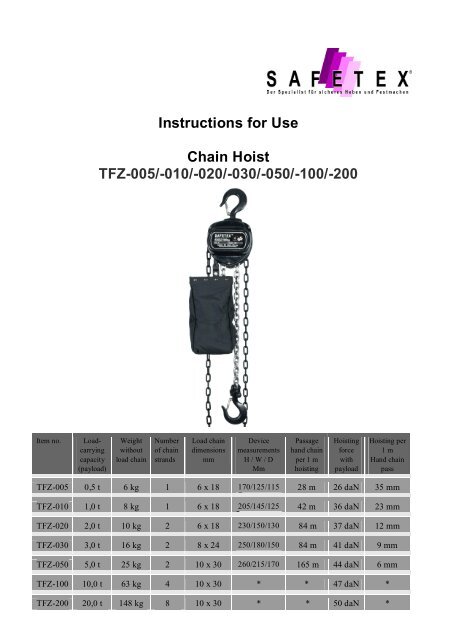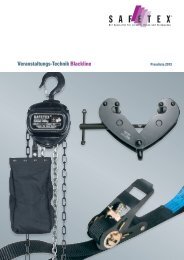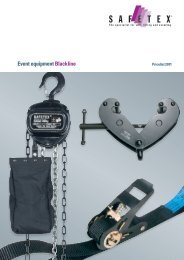Instructions for Use Chain Hoist TFZ-005 - SAFETEX Hebe
Instructions for Use Chain Hoist TFZ-005 - SAFETEX Hebe
Instructions for Use Chain Hoist TFZ-005 - SAFETEX Hebe
You also want an ePaper? Increase the reach of your titles
YUMPU automatically turns print PDFs into web optimized ePapers that Google loves.
Item no. Loadcarrying<br />
capacity<br />
(payload)<br />
Weight<br />
without<br />
load chain<br />
<strong>Instructions</strong> <strong>for</strong> <strong>Use</strong><br />
<strong>Chain</strong> <strong>Hoist</strong><br />
<strong>TFZ</strong>-<strong>005</strong>/-010/-020/-030/-050/-100/-200<br />
Number<br />
of chain<br />
strands<br />
Load chain<br />
dimensions<br />
mm<br />
Device<br />
measurements<br />
H / W / D<br />
Mm<br />
Passage<br />
hand chain<br />
per 1 m<br />
hoisting<br />
<strong>Hoist</strong>ing<br />
<strong>for</strong>ce<br />
with<br />
payload<br />
<strong>Hoist</strong>ing per<br />
1 m<br />
Hand chain<br />
pass<br />
<strong>TFZ</strong>-<strong>005</strong> 0,5 t 6 kg 1 6 x 18 170/125/115 28 m 26 daN 35 mm<br />
<strong>TFZ</strong>-010 1,0 t 8 kg 1 6 x 18 205/145/125 42 m 36 daN 23 mm<br />
<strong>TFZ</strong>-020 2,0 t 10 kg 2 6 x 18 230/150/130 84 m 37 daN 12 mm<br />
<strong>TFZ</strong>-030 3,0 t 16 kg 2 8 x 24 250/180/150 84 m 41 daN 9 mm<br />
<strong>TFZ</strong>-050 5,0 t 25 kg 2 10 x 30 260/215/170 165 m 44 daN 6 mm<br />
<strong>TFZ</strong>-100 10,0 t 63 kg 4 10 x 30 * * 47 daN *<br />
<strong>TFZ</strong>-200 20,0 t 148 kg 8 10 x 30 * * 50 daN *
Attention!<br />
Every user must read these instructions <strong>for</strong> use be<strong>for</strong>e using the device <strong>for</strong> the first time.<br />
They are intended <strong>for</strong> getting to know the hoisting device and taking advantage of its proper applications.<br />
These instructions <strong>for</strong> use have important indications on how to operate the hoisting device safely, properly<br />
and economically. Their observance helps to prevent hazards, reduce repair costs and downtime plus<br />
increase the reliability and useful life of the hoisting device. These instructions <strong>for</strong> use should always be<br />
available where the hoisting device will be used. Apart from the instructions <strong>for</strong> use and the obligatory<br />
country-specific safety prevention regulations, the recognized rules <strong>for</strong> safe and professional work must be<br />
observed.<br />
Intended use<br />
Maximum load, the payload indicated on the device, may not be exceeded.<br />
The device is suitable <strong>for</strong> hoisting loads. During hoisting, the supporting and load hook must be above the<br />
loadís center of gravity in a vertical straight line to prevent the load from oscillating. (Illustration 4)<br />
The operator may only start moving the load until he is sure that the load is correctly fastened and there<br />
are no persons in the danger zone. It is prohibited to stand or sit below a raised load (Illustration 2).<br />
When hooking up the device, the operator must be careful to use the hoisting device in a way that the<br />
device, suspension element or load will not endanger him.<br />
The device can be operated at an ambient temperature of -10 C to +50 C. In extreme situations, the<br />
manufacturer should be consulted.<br />
Attention! At ambient temperatures below 0 C, check brake <strong>for</strong> icing!<br />
The accident prevention and safety rules <strong>for</strong> manually operated hoisting devices of the country in which<br />
the device is used must be strictly observed.<br />
Proper use also includes ñ apart from observance of the instructions <strong>for</strong> use ñ compliance with the<br />
inspection and maintenance conditions.<br />
In case of malfunction, the hoisting device must be immediately taken out of service.<br />
Improper use<br />
The indicated payload may not be exceeded.<br />
The use of the hoisting device <strong>for</strong> transporting persons is prohibited (Illustration 1).<br />
Welding work on the hook, chain and device is prohibited. During welding work, the chain may not be<br />
employed as grounding cable.<br />
Diagonal pulling, i.e. lateral loading on the housing or bottom hook block, is prohibited (Illustration 3).<br />
The load chain may not be directly used as sling chain.<br />
Do not knot or connect the load chain with bolts, screws, splints or the like (Illustration 5).<br />
Load chains permanently installed in hoisting devices may not be repaired.<br />
The removal of the hook latch bolt from the support and load hooks is prohibited (Illustration 6).<br />
Always hook up the load in the middle of the hook, do not overload the hook tip (this also applies to the<br />
support hook).<br />
The operational turning of the load is prohibited. If an operational load turning is intended, so-called<br />
swivels must be installed.<br />
The chain end ring may not be used as hoist limit.<br />
Do not drop the hoisting device from a significant height. The device should always be properly laid down<br />
on the floor.
Hook bolt<br />
Illustration 1 Illustration 2 Illustration 3 Illustration 4 Illustration 5 Illustration 6<br />
Initial operation testing<br />
Be<strong>for</strong>e initial use, an expert must subject the hoisting device to a test. Possible defects must be corrected<br />
at once. This test consists largely of a visual and functional test. You must ensure that the device is in a<br />
safe position and defects or damages can be determined and corrected if applicable. Qualified persons<br />
can be deemed to be the service staff of the manufacturer or supplier, <strong>for</strong> example. The operator can also<br />
have skilled staff trained specifically <strong>for</strong> this purpose carry out the test.<br />
Be<strong>for</strong>e starting work, the device and supporting elements, chains, equipment and supporting<br />
construction must be inspected <strong>for</strong> obvious defects and malfunctions. Furthermore, the brake and correct<br />
hooking up of the device and load must be checked. To do this, lift and lower a load.<br />
The load chain and the support or load hook must be checked <strong>for</strong> external defects, de<strong>for</strong>mations,<br />
cracks, wear and corrosion as well as heavy wear and tear. It should also be checked <strong>for</strong> adequate<br />
lubrication.<br />
The chain end ring must always be mounted on the loose chain end.<br />
The load chain may not be twisted or intertwined, especially in devices with two or more strands. Check<br />
<strong>for</strong> correct chain alignment. The chain welding joint must point outwards.<br />
Function<br />
Safetex chain hoists have been exclusively approved <strong>for</strong> ñ and must be used with ñ original Safetex<br />
chains. A perfect function is only guaranteed with original chains. It must be ensured that only chains<br />
corresponding to the size of the device type are used.<br />
Initial operation<br />
When anchoring the chain hoist, make sure that the supporting construction has been statically laid out <strong>for</strong><br />
accepting the corresponding payload. The chain hoist must be safely hooked up and the hook latch bolt on<br />
the supporting hook 1 closed in order to secure the chain hoist against unhooking.<br />
<strong>Hoist</strong>ing: Pull the hand chain 5 <strong>for</strong> lifting the load. The unloaded load chain 4 must be stored either in the<br />
chain storage receptacle or on the device in orderly fashion.<br />
Lowering: Move the hand chain 5 in the opposite direction of hoisting.<br />
Moving the load: Always hook up the load in the middle of the hook, do not load the hook tip.<br />
It must be possible to guide both the hand chain 5 and the load chain 4 freely through the device<br />
Carrying capacity according to designation 1:1 (test load 1:1.5).<br />
The accident prevention rules <strong>for</strong> hoisting devices and the guidelines <strong>for</strong> chains and load suspension<br />
elements must be observed.
1 Support hook with hook latch bolt<br />
2 Load hook with hook latch bolt<br />
3 Bottom hook block<br />
4 Load chain<br />
5 Hand chain<br />
6 <strong>Chain</strong> end piece<br />
7 Gear cover<br />
8 Hand wheel cover<br />
9 Hand wheel<br />
1<br />
2<br />
3<br />
Inspection-Maintenance<br />
A yearly inspection of the device must be carried out on a regular basis by a qualified individual, who<br />
must ensure that device and accessories remain in safe condition. If the device is used with heavy loads,<br />
testing should be done in shorter intervals.<br />
Inspections are largely visual and functional tests. The condition of the structural components<br />
regarding damage, wear, corrosion or other changes must be assessed, as well as the completeness and<br />
effectiveness of the safety devices. To check parts subject to wear and tear, a disassembly may be<br />
necessary. For checking the hoisting, pulling and lowering functions, a payload equivalent to the nominal<br />
load is generally required. Only authorized specialized shops that use original Safetex spare parts may<br />
repair our products.<br />
The operator of the device must order the inspections and record them in the instructions <strong>for</strong> use<br />
Declaration of con<strong>for</strong>mity ñ in accordance with guideline 2006/42/EC<br />
It is hereby confirmed that the conception, design and execution of the devices we market described<br />
in these instructions <strong>for</strong> use comply with the pertinent, basic safety and health requirements of EC<br />
guideline 2006/42/EC <strong>for</strong> machinery. If the device is modified or supplemented without our knowledge, this<br />
EC declaration of con<strong>for</strong>mity will cease to be valid. This EC declaration of con<strong>for</strong>mity will also cease to be<br />
valid if the machine is not used as intended according to the uses indicated in these instructions <strong>for</strong> use<br />
and the tests are not regularly per<strong>for</strong>med.<br />
Standards-Guidelines<br />
EC guideline 2006/42/EC <strong>for</strong> machines<br />
DIN EN 349 machine safety<br />
Final inspection<br />
Type of device Series number Inspector Date<br />
<strong>TFZ</strong>-<br />
Test report / Inspection<br />
Inspection remark Inspector Date<br />
6<br />
4<br />
8<br />
9<br />
5<br />
7
Exploded view:<br />
No. Description<br />
1 Friction plate brake pad<br />
2 Brake disk<br />
3 Guiding roller<br />
4 Safety catch<br />
5 Load hook complete<br />
6 Device hook complete<br />
7 Spare part set <strong>for</strong> hook<br />
List of spare parts<br />
1<br />
No. For <strong>TFZ</strong>-<strong>005</strong> <strong>for</strong> <strong>TFZ</strong>-010 <strong>for</strong> <strong>TFZ</strong>-020 <strong>for</strong> <strong>TFZ</strong>-030 <strong>for</strong> <strong>TFZ</strong>-050 <strong>for</strong> <strong>TFZ</strong>-100 <strong>for</strong> <strong>TFZ</strong>200<br />
1 -<strong>005</strong>-ET-RP -010-ET-RP -020-ET-RP -030-ET-RP -050-ET-RP -100-ET-RP -200-ET-RP<br />
2 -<strong>005</strong>-ET-BS -010-ET-BS -020-ET-BS -030-ET-BS -050-ET-BS -100-ET-BS -200-ET-BS<br />
3 -<strong>005</strong>-ET-LR -010-ET-LR -020-ET-LR -030-ET-LR -050-ET-LR -100-ET-LR -200-ET-LR<br />
4 -<strong>005</strong>-ET-SK -010-ET-SK -020-ET-SK -030-ET-SK -050-ET-SK -100-ET-SK -200-ET-SK<br />
5 -<strong>005</strong>-ET-LH -010-ET-LH -020-ET-LH -030-ET-LH -050-ET-LH -100-ET-LH -200-ET-LH<br />
2<br />
6 -<strong>005</strong>-ET-GH -010-ET-GH -020-ET-GH -030-ET-GH -050-ET-GH -100-ET-GH -200-ET-GH<br />
7 -<strong>005</strong>-ET-EG -010-ET-EG -020-ET-EG -030-ET-EG -050-ET-EG -100-ET-EG -200-ET-EG<br />
<strong>TFZ</strong>-BA-<strong>005</strong>-200-D 01/2012<br />
Item numbers ñ when ordering include <strong>TFZ</strong> be<strong>for</strong>e the item number<br />
<strong>SAFETEX</strong> Æ<br />
<strong>Hebe</strong>- und Transporttechnik GmbH<br />
Hafenbahnstrafle 10 A<br />
D-70329 Stuttgart<br />
Phone +49 (0)711/322039<br />
Fax +49 (0)711/329297<br />
www.safetex.de info@safetex.de<br />
4<br />
6<br />
5<br />
Principle sketch<br />
3




